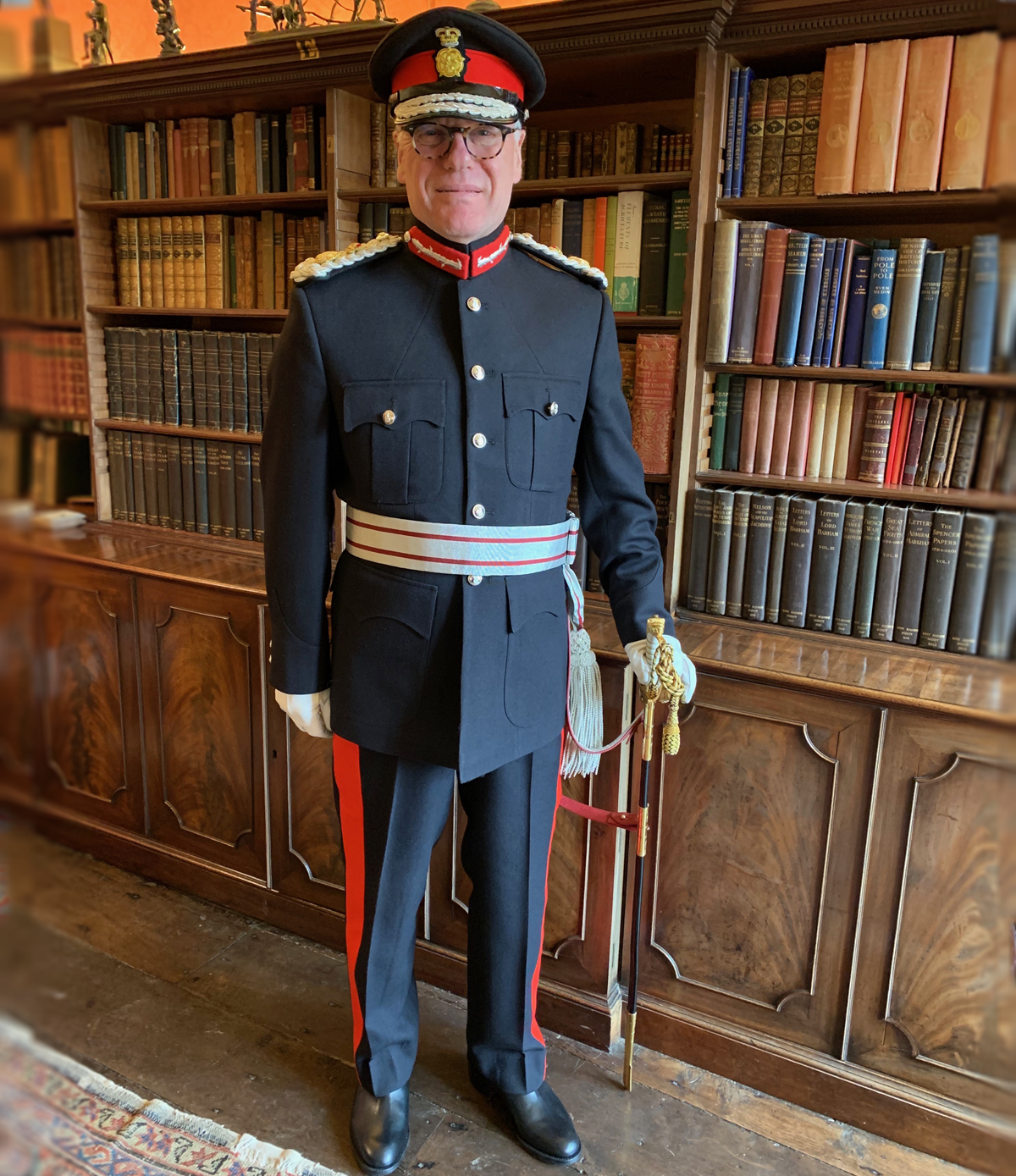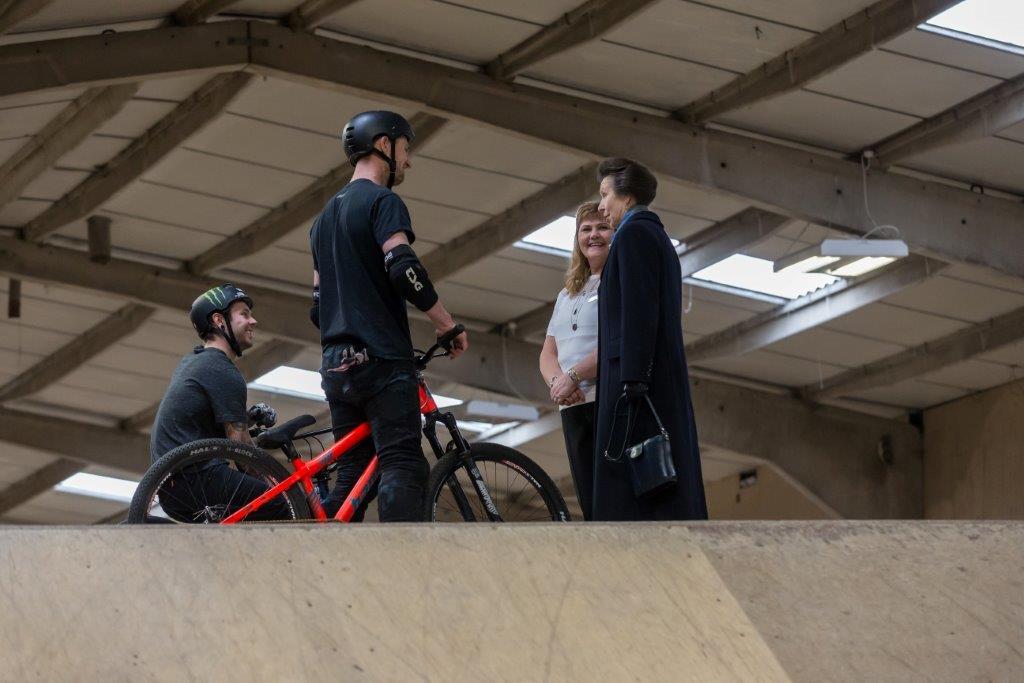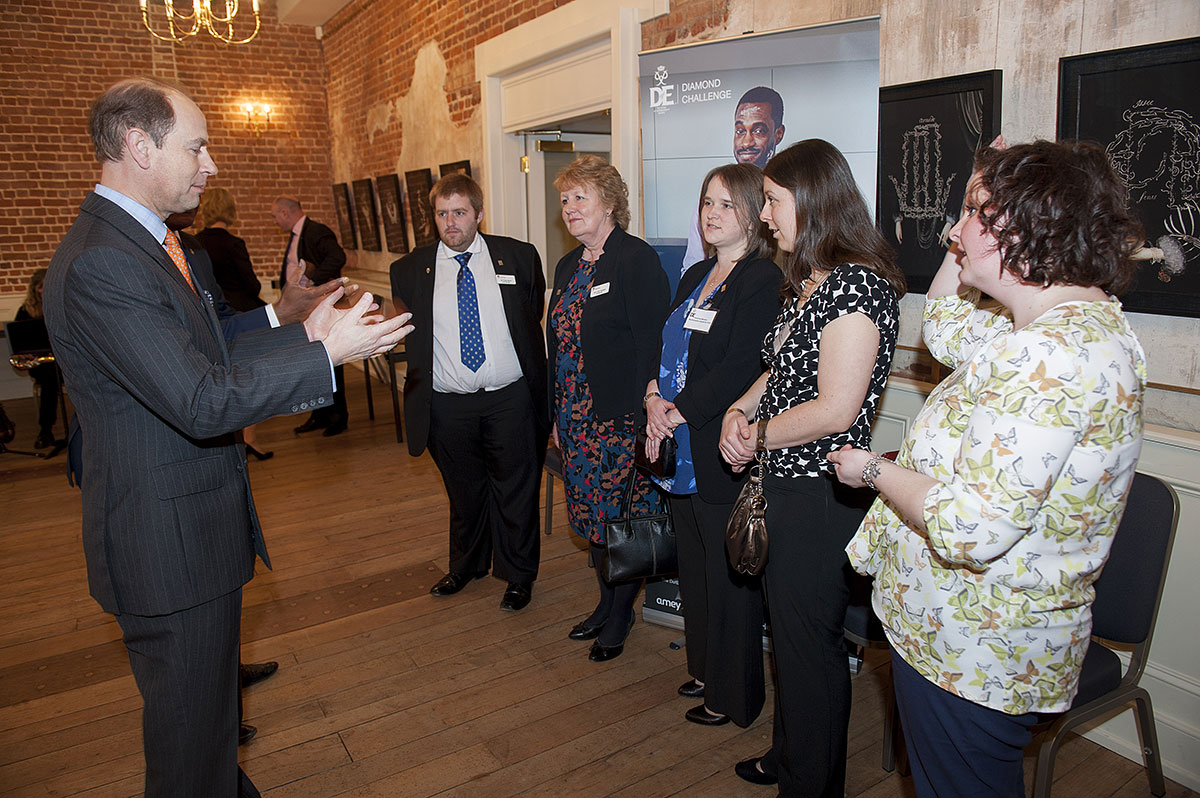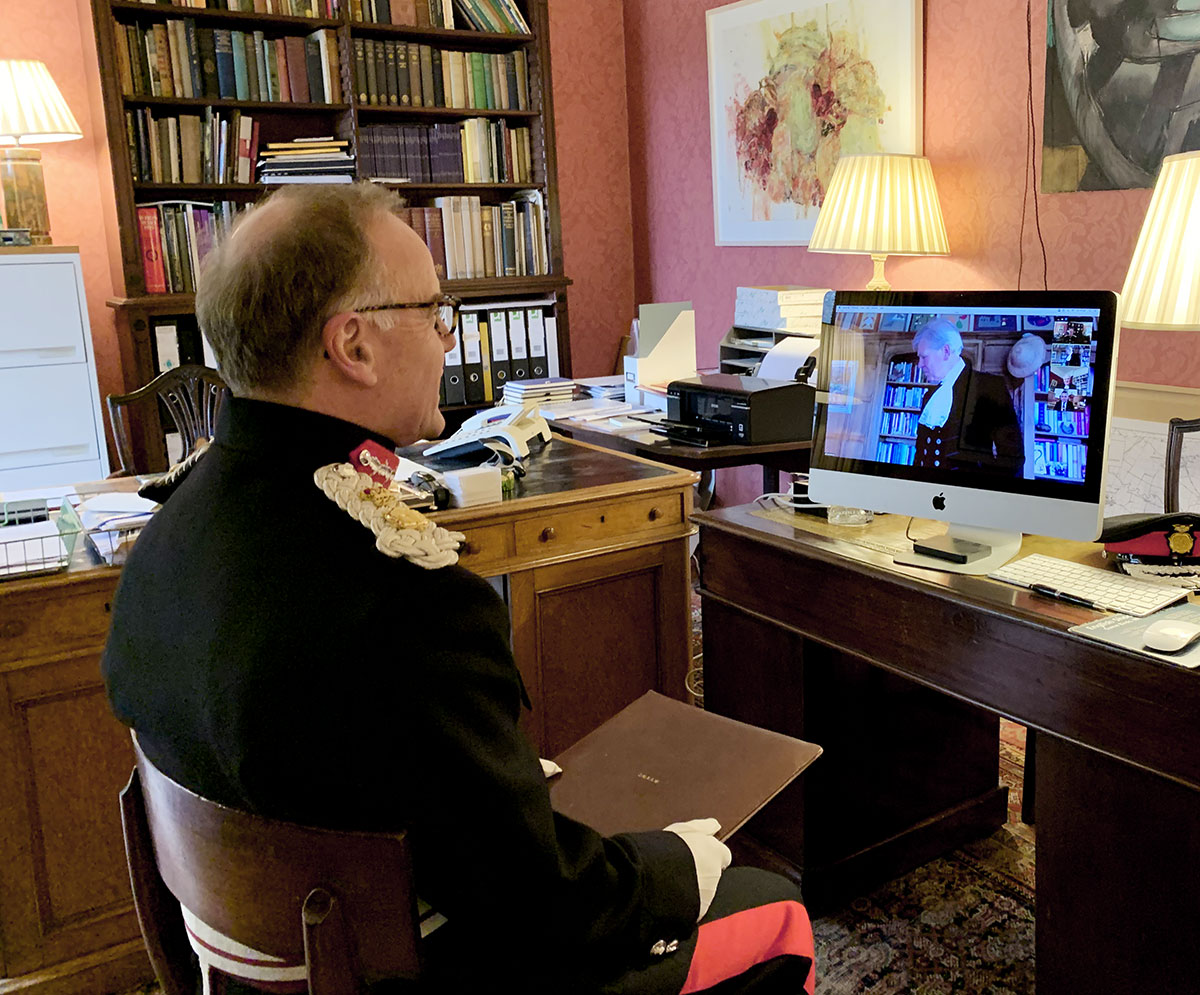Overview
The fundamental principle concerning the office of Lord-Lieutenant is that he/she is His Majesty’s representative in the County and consequently it is the first and foremost duty to uphold the dignity of the Crown.
The Lord-Lieutenant, following the example of His Majesty The King, seeks to promote a good atmosphere and a spirit of co-operation by the encouragement given to voluntary services and to benevolent organisations, and by the interest taken in the industrial and social life of the County.
The main duties of the Lord-Lieutenant may be classified under the following:
![]() Hosting visits by members of the Royal Family to the County
Hosting visits by members of the Royal Family to the County
![]() Presentation of awards and medals
Presentation of awards and medals
![]() Representing His Majesty The King at events in the County
Representing His Majesty The King at events in the County
![]() Appointment of the Vice Lord-Lieutenant and Deputy Lieutenants
Appointment of the Vice Lord-Lieutenant and Deputy Lieutenants
![]() Is the King’s representative in the County for the Armed Forces, reserves and cadets
Is the King’s representative in the County for the Armed Forces, reserves and cadets
![]() Supporting the uniformed emergency services and cadets
Supporting the uniformed emergency services and cadets
![]() Is the ‘Custos Rotulorum’ (the Keeper of the Rolls in the County)
Is the ‘Custos Rotulorum’ (the Keeper of the Rolls in the County)
![]() Chairing the Lord Chancellor’s Advisory Committee (the Magistracy)
Chairing the Lord Chancellor’s Advisory Committee (the Magistracy)
![]() Promoting Civic, Commerce, Heritage, The Arts, Education and Sport
Promoting Civic, Commerce, Heritage, The Arts, Education and Sport
![]() Supporting the non-uniformed services
Supporting the non-uniformed services
![]() Visiting and supporting charitable organisations
Visiting and supporting charitable organisations
Visits of Members of the Royal Family to the County
It is the role of the Lord-Lieutenant to welcome any member of the Royal Family to the county if it is an official visit. Recent royal visits to the county have included:
![]() 29 October 2025 – The Princess Royal visited Edward Green Co Ltd, Northampton
29 October 2025 – The Princess Royal visited Edward Green Co Ltd, Northampton
![]() 29 October 2025 – The Princess Royal visited The Bridge Substance Misuse Programme, Northampton
29 October 2025 – The Princess Royal visited The Bridge Substance Misuse Programme, Northampton
![]() 29 October 2025 – The Princess Royal visited The Good Loaf, Northampton
29 October 2025 – The Princess Royal visited The Good Loaf, Northampton
![]() 29 October 2025 – The Princess Royal visited ‘Conversation with Cadets, Army Reserves Centre, Northampton
29 October 2025 – The Princess Royal visited ‘Conversation with Cadets, Army Reserves Centre, Northampton
![]() 20 July 2022 – The Princess Royal visited Chester House Estate, Irchester
20 July 2022 – The Princess Royal visited Chester House Estate, Irchester
![]() 17 July 2025 – The Princess Royal visited Hankook Tyre, Daventry
17 July 2025 – The Princess Royal visited Hankook Tyre, Daventry
![]() 17 July 2025 – The Princess Royal visited Wellingborough Hindu District Association
17 July 2025 – The Princess Royal visited Wellingborough Hindu District Association
![]() 20 July 2025 – The Princess Royal visited Chester House Estate, Irchester
20 July 2025 – The Princess Royal visited Chester House Estate, Irchester
![]() 09 June 2025 – The Duchess of Edinburgh visited Growing Together Nursery, Blackthorn, Northampton
09 June 2025 – The Duchess of Edinburgh visited Growing Together Nursery, Blackthorn, Northampton
![]() 09 June 2025 – The Duchess of Edinburgh visited Northampton, Museum, All Saints Church, Market Square, Guildhall
09 June 2025 – The Duchess of Edinburgh visited Northampton, Museum, All Saints Church, Market Square, Guildhall
09 June 2025 – The Duchess of Edinburgh visited Northampton, Museum, All Saints Church, Market Square, Guildhall
09 June 2025 – The Duchess of Edinburgh visited Northampton, Bike Park.
![]() 29th April 2025 – HRH The Princess Royal Youth Court Solutions at Wellingborough Magistrates Court
29th April 2025 – HRH The Princess Royal Youth Court Solutions at Wellingborough Magistrates Court
![]() 30 October 2024 – HRH The Duke of Gloucester visited HMP Five Wells, Wellingborough
30 October 2024 – HRH The Duke of Gloucester visited HMP Five Wells, Wellingborough
![]() 30 October 2024 – HRH The Duke of Gloucester visited Rock UK Frontier Centre, Irthlingborough
30 October 2024 – HRH The Duke of Gloucester visited Rock UK Frontier Centre, Irthlingborough
![]() 30 October 2024 – HRH The Duke of Gloucester visited The Frank Bruno Foundation, Northampton
30 October 2024 – HRH The Duke of Gloucester visited The Frank Bruno Foundation, Northampton
![]() 30 October 2024 – HRH The Duke of Gloucester visited NGH to officially unveil the Organ Donor Memorial
30 October 2024 – HRH The Duke of Gloucester visited NGH to officially unveil the Organ Donor Memorial
![]() 16 February 2024 – HRH The Princess Royal Visited Off The Streets NN CIC, Wellingborough
16 February 2024 – HRH The Princess Royal Visited Off The Streets NN CIC, Wellingborough
![]() 30 June 2022 – HRH The Duke of Gloucester visited Prince William School, Oundle
30 June 2022 – HRH The Duke of Gloucester visited Prince William School, Oundle
![]() 07 November 2023 – HRH The Duke of Gloucester visited Fulkrum Technical Resources, Corby
07 November 2023 – HRH The Duke of Gloucester visited Fulkrum Technical Resources, Corby
![]() 07 November 2023 – HRH The Duke of Gloucester visited Corby Sixth Form College
07 November 2023 – HRH The Duke of Gloucester visited Corby Sixth Form College
![]() 07 November 2023 – HRH The Duke of Gloucester visited Adrenaline Alley, Corby
07 November 2023 – HRH The Duke of Gloucester visited Adrenaline Alley, Corby
![]() 07 November 2023 – HRH The Duke of Gloucester visited Cransley Hospice Trust, Kettering
07 November 2023 – HRH The Duke of Gloucester visited Cransley Hospice Trust, Kettering
![]() 24 June 2023 – HRH The Princess Royal Visited Icelandic Horse Society, GB, Daventry
24 June 2023 – HRH The Princess Royal Visited Icelandic Horse Society, GB, Daventry
![]() 06 June 2023 – HRH The Princess Royal Visited MND Association, Boughton Estate, Kettering
06 June 2023 – HRH The Princess Royal Visited MND Association, Boughton Estate, Kettering
![]() 20 July 2022 – HRH The Princess Royal Visited Chester House Estate, Irchester
20 July 2022 – HRH The Princess Royal Visited Chester House Estate, Irchester
![]() 20 July 2022 – HRH The Princess Royal Visited MND Association, Northampton
20 July 2022 – HRH The Princess Royal Visited MND Association, Northampton
![]() 30 June 2022 – HRH The Duke of Gloucester visited Moulton Agricultural College, Mouton, Northampton
30 June 2022 – HRH The Duke of Gloucester visited Moulton Agricultural College, Mouton, Northampton
![]() 30 June 2022 – HRH The Duke of Gloucester visited the Northampton Museum and Art Gallery
30 June 2022 – HRH The Duke of Gloucester visited the Northampton Museum and Art Gallery
![]() 6 April 2022 – HRH The Princess Royal visited the Security Institute Next Generation Programme at the former RAF Grafton Underwood, Kettering
6 April 2022 – HRH The Princess Royal visited the Security Institute Next Generation Programme at the former RAF Grafton Underwood, Kettering
![]() 14th September 2021 – HRH The Princess Royal visited Northampton General Hospital,
14th September 2021 – HRH The Princess Royal visited Northampton General Hospital,
![]() 14th September 2021 – HRH The Princess Royal visited Northgate School Arts College The Beehive, Northampton
14th September 2021 – HRH The Princess Royal visited Northgate School Arts College The Beehive, Northampton
![]() 14th September 2021 – HRH The Princess Royal visited IHWO (Indian Hindu Welfare Organisation) Chai and Chat Ladies Group, Northampton
14th September 2021 – HRH The Princess Royal visited IHWO (Indian Hindu Welfare Organisation) Chai and Chat Ladies Group, Northampton
![]() 8th September 2021 – Their Royal Highnesses, The Earl and Countess of Wessex visited Corona Kitchen in Kettering
8th September 2021 – Their Royal Highnesses, The Earl and Countess of Wessex visited Corona Kitchen in Kettering
![]() 8th September 2021 – Their Royal Highnesses, The Earl and Countess of Wessex visited Kingswood Neighbourhood Centre in Corby
8th September 2021 – Their Royal Highnesses, The Earl and Countess of Wessex visited Kingswood Neighbourhood Centre in Corby
![]() 8th September 2021 – Their Royal Highnesses, The Earl and Countess of Wessex visited Home-Start Corby.
8th September 2021 – Their Royal Highnesses, The Earl and Countess of Wessex visited Home-Start Corby.
![]() 27th April 2021 – HRH The Princess Royal visited Siri Guru Singh Sabha Northampton and Sikh Community Centre and Youth Club
27th April 2021 – HRH The Princess Royal visited Siri Guru Singh Sabha Northampton and Sikh Community Centre and Youth Club
![]() 27th April 2021 – HRH The Princess Royal visited Bambino Mio Ltd – Brixworth
27th April 2021 – HRH The Princess Royal visited Bambino Mio Ltd – Brixworth
![]() 27th April 2021 – HRH The Princess Royal visited Scott Bader Company Ltd, Wellingborough.
27th April 2021 – HRH The Princess Royal visited Scott Bader Company Ltd, Wellingborough.
![]() 14th October 2020 – HRH The Princess Royal visited Wellingborough School
14th October 2020 – HRH The Princess Royal visited Wellingborough School
![]() 14th October 2020 – HRH The Princess Royal visited Blisworth Marina, Crusader Community Boating
14th October 2020 – HRH The Princess Royal visited Blisworth Marina, Crusader Community Boating
![]() 23rd May 2019 – HRH The Duke of Gloucester visited SATRA, Boughton House and the Northern Accommodation Block for Northamptonshire Police, all in or near Kettering
23rd May 2019 – HRH The Duke of Gloucester visited SATRA, Boughton House and the Northern Accommodation Block for Northamptonshire Police, all in or near Kettering
![]() 5th April 2019 – HRH The Princess Royal attended the Corporate Member Day of the Chartered Institute of Logistics UK in Daventry
5th April 2019 – HRH The Princess Royal attended the Corporate Member Day of the Chartered Institute of Logistics UK in Daventry
![]() 28th January 2019 – HRH The Prince of Wales visited two shoe companies: Trickers in Northampton and Gaziano & Girling in Kettering
28th January 2019 – HRH The Prince of Wales visited two shoe companies: Trickers in Northampton and Gaziano & Girling in Kettering
![]() 20th November 2018 – The Countess of Wessex visited Fairfields School, Northampton
20th November 2018 – The Countess of Wessex visited Fairfields School, Northampton
![]() 21st September 2018 – HRH The Princess Royal visited The Daylight Centre, Save the Children in Higham Ferrers and Northampton Town Football Club Education Centre, Northampton
21st September 2018 – HRH The Princess Royal visited The Daylight Centre, Save the Children in Higham Ferrers and Northampton Town Football Club Education Centre, Northampton
![]() 7th March 2018 – HRH Prince Harry, Royal Patron of The Silverstone Experience, visited The Silverstone Experience and UTC
7th March 2018 – HRH Prince Harry, Royal Patron of The Silverstone Experience, visited The Silverstone Experience and UTC
Requesting a visit by a member of the Royal Family
If you would like to request a member of the Royal Family to visit your organisation, you need to write to the Private Secretary to the member of the Royal Family you wish to invite at least six months ahead of the planned event. The addresses are available on the website for the Royal Family: www.royal.uk/contact. It is most helpful if you can inform the Lord-Lieutenant if you have submitted an invitation please.
If the member of the Royal Family is able to accept an invitation, the Lord-Lieutenant is informed by the appropriate Private Secretary about three months ahead of the event. Details of the visits are often not publicised until much closer to the date.
Presentation of Medals
His Majesty The King may express his wish that a Lord-Lieutenant should present certain medals on his behalf, including British Empire Medals, King’s Police Medals, Fire Service Medals, King’s Commendations for Brave Conduct and the Legion d’Honneur for D-Day Veterans.
It is the duty of the Lord-Lieutenant in these circumstances to make the presentation himself whenever possible, though the duty may be deputed if necessary. He usually makes the presentation either by visiting the home, a place of work of the recipient or at County Hall.
At private investitures, it is customary for a few guests to be drawn from the civic authorities and the recipient’s employer and family.
To allow time for the engraving and distribution of medals, it is desirable to arrange the presentation ceremony not less than about eight weeks after the publication of the Honours List.
When presenting medals on behalf of His Majesty The King, The Lord-Lieutenant wears uniform since he is directly representing His Majesty.
Royal Navy, Army and Royal Air Force
The Lord-Lieutenant may be called upon to carry out a variety of duties connected with the armed forces of the Crown, as for example:
![]() He may be commanded by His Majesty The King to present colours
He may be commanded by His Majesty The King to present colours
![]() He may be invited by the Commander concerned:
He may be invited by the Commander concerned:
- to inspect troops on parade, including taking the salute on arrival and during the march past
- to inspect a guard of honour
- to receive colours at a laying up ceremony
- to receive units on their return from services overseas
- to take part in various ceremonial functions.
In all events the Lord-Lieutenant will wear the uniform of Lord-Lieutenant and take precedence of all those attending, including Ministers of the Crown.
A Lord-Lieutenant is entitled to inspect and to take salute at a parade of his County Territorial and Army Volunteer Reserve units in any county where they may be stationed. It is usual, as an act of courtesy, to notify his intention to the Lord-Lieutenant of the county to be visited.
When the Lord-Lieutenant has been expressly instructed to deputise for the Sovereign, for instance when His Majesty has instructed the Lord-Lieutenant to present colours on His behalf, he should be received with a Royal salute and the National Anthem should be played.
On all other occasions, the Lord-Lieutenant should be saluted by troops in his capacity as military commander, that is to say, he should be received with a general salute and by the band playing the first part of a slow march, not the National Anthem.
When a regiment parades for the purposes of receiving the equivalent of the freedom of a city or borough, it is right to make the Lord Mayor or Mayor of the city or borough make the presentation and take the salute.
Custos Rotulorum and Lord Chancellor’s Advisory Committee
The custos rotulorum is the keeper of an English, Welsh and Northern Irish county’s records and, by virtue of that office, the highest civil officer in the county. The position is now largely ceremonial. The appointment until 1545, lay with the Lord Chancellor, but is now exercised by the Crown, under the Royal sign-manual, and was usually held by a person of rank. The appointment has been united with that of the lord-lieutenancy of the county throughout England since 1836.
In practice, the records were in the custody of the clerk of the peace. This latter official was, until 1888, appointed by the custos rotulorum, but following the passing of the Local Government Act of that year, the appointment was made by the standing joint-committee of the county council. The post of clerk of the peace was abolished by the Courts Act 1971.









